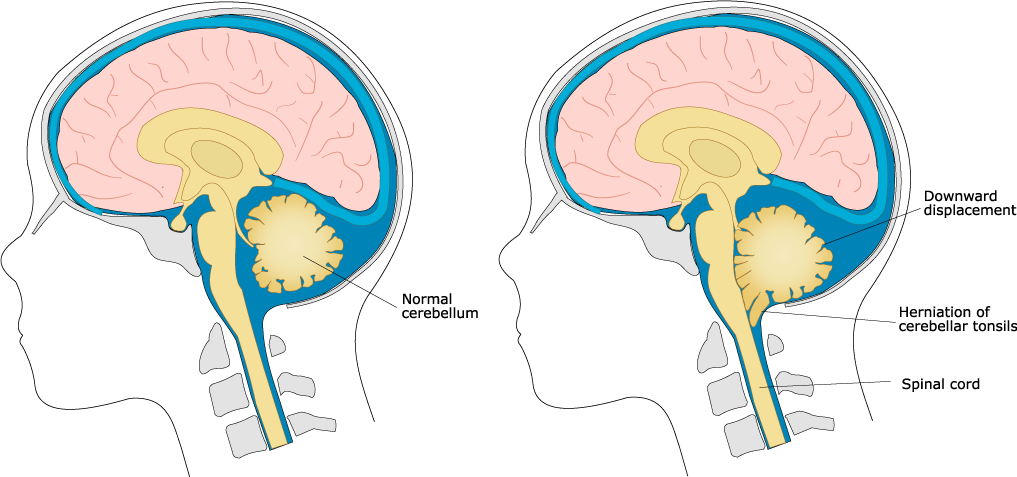
Chiari malformation is a condition in which brain tissue extends into the spinal canal. It occurs when a part of the skull is abnormally small or misshaped, pressing on the brain and forcing it downward.
Chiari malformation are structural defects in the cerebellum. It is the part of the brain that controls balance.
Types
Doctors categorize chiari malformation into three types, depending on the anatomy of the brain tissue that is displaced into the spinal canal and whether developmental abnormalities of the brain or spine are present.
There are four types of chiari malformations:
- Type I – this is by far the most commonly observed type in children. In this type, the lower part of the cerebellum — but not the brain stem — extends into an opening at the base of the skull. The opening is called the foramen magnum. Normally, only the spinal cord passes through this opening.
Type I is the only type of chiari malformation that can be acquired.
- Type II – this is usually only seen in children born with spina bifida. Spina bifida is the incomplete development of the spinal cord/or its protective covering.
Type II is also known as “classic” Chiari malformation or Arnold-Chiari malformation. In type II chiari malformation, both cerebellum and the brain stem extend into the foramen magnum.
- Type III – is the most serious form of chiari malformation. It involves the protrusion or herniation of the cerebellum and brain stem through the foramen magnum and into the spinal cord. This usually causes severe neurological defects. Type III is a rare type.
- Type IV – this involves an incomplete or undeveloped cerebellum. It sometimes is associated with exposed parts of the skull and spinal cord. Type IV is a rare type.
Symptoms
Chiari malformation is associated with a wide range of symptoms which vary by type.
Type I Chiari malformation usually causes no symptoms. Most people with the condition don’t even know that they have it unless it is incidentally discovered during a diagnostic imaging test.
But if the malformation is severe, type I may cause symptoms such as;
- Pain in the lower back of the head in the neck; it usually develops quickly and intensifies with any activity that increases pressure in the brain, such as coughing and sneezing.
- Dizziness and problems with balance and coordination
- Swallowing difficulties
- Sleep apnea
Most children born with type II chiari malformation have hydrocephalus. Older children with type II chiari malformation may develop head pain associated with;
- Coughing or sneezing
- Bending over
- Strenuous physical activities
- Straining to have a bowel movement
Some of the most common symptoms are linked to problems with the function of nerves in the brain stem. These include;
- Weakness of vocal cords
- Swallowing difficulties
- Breathing irregularities
- Serious changes in the function of nerves in the throat and tongue
Treatment for Chiari Malformations
If a chiari malformation is suspected, a doctor will perform a physical exam. The doctor will also check functions controlled by the cerebellum and spinal cord. These functions include;
- Balance
- Touch
- Reflexes
- Sensation
- Motor skills
If chiari malfunction causes no symptoms and does not interfere with activities of daily living, no treatment is necessary. In other cases, medications can be used to manage symptoms such as pain.
Surgery is the only treatment that can correct functional defects or stop progression of damage to the central nervous system.
In both type I and type II chiari malformations, the goals of surgery are to;
- Relieve pressure on the brain and spinal cord
- Re-establish normal fluid circulation through and around the area
What We Offer
We at Almurshidi Medical Tourism will find the best doctors to cater to your needs. We are partnered with a wide network of hospitals and clinics that provide top quality medical experience.
We provide free medical estimates, make medical appointments, and provide several medical opinions if needed at no cost.
Contact Us
For more information contact us at +66822004040 or via WhatsApp








